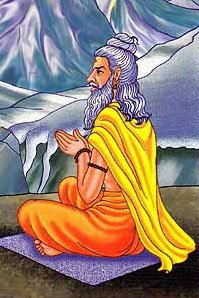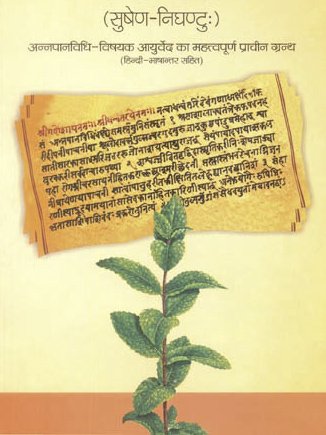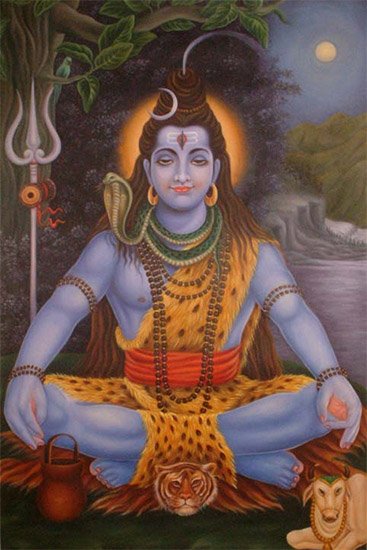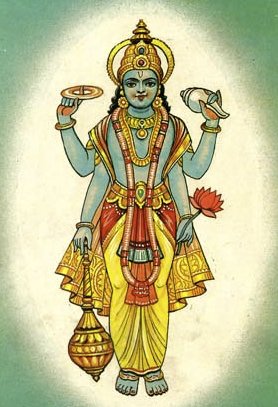Anagha, Anaghā: 24 definitions
Introduction:
Anagha means something in Hinduism, Sanskrit, Jainism, Prakrit, Marathi. If you want to know the exact meaning, history, etymology or English translation of this term then check out the descriptions on this page. Add your comment or reference to a book if you want to contribute to this summary article.
In Hinduism
Purana and Itihasa (epic history)
Source: archive.org: Puranic Encyclopedia1) Anagha (अनघ).—Son of Vasiṣṭha. He had seven sons, by his wife Ūrjā. They were: Rajas, Gotra, Ūrdhvabāhu, Savana, Anagha, Sutapas and Śukra. Holy characters, they became the saptarṣis of the age of the third Manu. (Manvantara).
2) Anagha (अनघ) was a Gandharva. He participated in the birthday celebrations of Arjuna. (Mahābhārata, Ādi Parva, Chapter 122, Verse 55).
3) Anagha (अनघ).—A king called Anagha is referred to in Verse 22, Chapter 8 of M.B.
4) Anagha (अनघ).—Skanda has a synonym, Anagha as well. (Mahābhārata, Vana Parva, Chapter 232, Verse 5).
5) Anagha (अनघ).—A bird named Anagha is mentioned among the children of Garuḍa. (Mahābhārata, Udyoga Parva, Chapter 101, Verse 12).
6) Anagha (अनघ).—Used as a synonym of Śiva. (Mahābhārata, Anuśāsana Parva, Chapter 17, Verse 38).
7) Anagha (अनघ).—A synonym of Viṣṇu. (Mahābhārata, Anuśāsana Parva, Chapter 149, Verse 29).
Source: archive.org: Shiva Purana - English TranslationAnagha (अनघ) refers to “flawless”, according to the Śivapurāṇa 2.2.43.—Accordingly, as Brahmā narrated to Nārada:—“[...] thus I have described the fascinating story of Satī (i.e., satīcaritra) to you which confers worldly pleasures and salvation, which is divine and bestows all wishes. This narrative is flawless (i.e., anagha), pure, sanctifying, conferring heavenly pleasures, glory, longevity and the pleasure of sons and grandsons”.
Source: Cologne Digital Sanskrit Dictionaries: The Purana Index1a) Anagha (अनघ).—The son of Upadānavī: The Vaibhrāja king of Pāñcāla: Father of Brahmadatta.*
- * Matsya-purāṇa 21. 11.
1b) A Mauneya.*
- * Vāyu-purāṇa 69. 1.
1c) A son of Trasu.*
- * Vāyu-purāṇa 99. 133.
1d) A son of Ūrja and Vasiṣṭha; a sage of XIth epoch of Manu.*
- * Viṣṇu-purāṇa I. 10. 13: III. 2. 31.
2) Anaghā (अनघा).—A river of Śākadvīpa.*
- * Bhāgavata-purāṇa V. 20. 26.
Anagha (अनघ) is a name mentioned in the Mahābhārata (cf. XIV.8.23, XIV.8) and represents one of the many proper names used for people and places. Note: The Mahābhārata (mentioning Anagha) is a Sanskrit epic poem consisting of 100,000 ślokas (metrical verses) and is over 2000 years old.
Source: Shodhganga: The saurapurana - a critical study1) Anagha (अनघ) refers to one of the seven sons of Vasiṣṭha and Ūrjā: one of the twenty-four daughters of Dakṣa and Prasūti, according to the Vaṃśa (‘genealogical description’) of the 10th century Saurapurāṇa: one of the various Upapurāṇas depicting Śaivism.—Accordingly, Ākūti was married to Ruci and Prasūti to Dakṣa. Dakṣa produced in Prasūti twenty-four daughters. [...] [Ūrjā was given to Vasiṣṭha.] From Vasiṣṭha and Ūrjā, seven sons—Raja, Gotra, Ūrdhvabāhu, Savana, Anagha, Sutapā and Śukla and a daughter Puṇḍarikā were born.
2) Anagha (अनघ) is the name of one of the seven sages (saptarṣi) in the Uttama-Manvantara: one of the fourteen Manvantaras.—Accordingly, “In the Uttama Manvantara the Sudhāmās are the Gods having twelve groups like Pratardana, Śiva, Satya, Vaśavarti etc. Sudānti was the Indra. Raja, Gotra, Ardhabāhu, Savana, Anagha, Sutapā and Śukra are the Seven sages.

The Purana (पुराण, purāṇas) refers to Sanskrit literature preserving ancient India’s vast cultural history, including historical legends, religious ceremonies, various arts and sciences. The eighteen mahapuranas total over 400,000 shlokas (metrical couplets) and date to at least several centuries BCE.
Ayurveda (science of life)
Veterinary Medicine (The study and treatment of Animals)
Source: Shodhganga: Portrayal of Animal Kingdom (Tiryaks) in Epics An Analytical studyAnagha (अनघ) (lit. “one who is faultless”) is a synonym (another name) for Garuḍa, according to scientific texts such as the Mṛgapakṣiśāstra (Mriga-pakshi-shastra) or “the ancient Indian science of animals and birds” by Hamsadeva, containing the varieties and descriptions of the animals and birds seen in the Sanskrit Epics such as the Ramayana and Mahabharata.

Āyurveda (आयुर्वेद, ayurveda) is a branch of Indian science dealing with medicine, herbalism, taxology, anatomy, surgery, alchemy and related topics. Traditional practice of Āyurveda in ancient India dates back to at least the first millenium BC. Literature is commonly written in Sanskrit using various poetic metres.
Shaivism (Shaiva philosophy)
Source: Brill: Śaivism and the Tantric TraditionsAnagha (अनघ) refers to “faultless”, as quoted by Hṛdayaśiva in his Prāyaścittasamuccaya (verse 10.27-35).—Accordingly, “Having recited [a particular mantra] along with [the practice of one of the] observances in accordance with the rules, and having bathed [at the end of the observance], one may recite that mantra for attaining supernatural powers. [...] Being thus bathed after the observance [in propitiation] of [his] mantra, invested in the right to [pursue] all [manner of special powers], faultless (anagha), he should then recite [his chosen] mantra according to the rules of his hand-book, without being afraid”.

Shaiva (शैव, śaiva) or Shaivism (śaivism) represents a tradition of Hinduism worshiping Shiva as the supreme being. Closely related to Shaktism, Shaiva literature includes a range of scriptures, including Tantras, while the root of this tradition may be traced back to the ancient Vedas.
Vaishnavism (Vaishava dharma)
Source: Brill: Śaivism and the Tantric Traditions (vaishnavism)Anaghā (अनघा) refers to “(being) free of sin”, according to the Vedānta Deśika’s Yatirājasaptati.—This view of Rāmānuja’s central role in the establishment of a new, Viśiṣṭādvaita Vedānta is the second central motif in the poem. Thus, even while we also have verses in the poem that, like in the Irāmāṉuja Nūṟṟantāti, echo the sentiments of taking refuge at the feet of Rāmānuja, such as verses Verse 18, where those who take refuge at the feet of Yatipati become free of sin (anaghā) or Verse 20, where the feet are a refuge compared to medicine that stills the fluctuations of the mind, it becomes clear that the framework of the poem does not allow for a predominant focus on the analogy between Rāmānuja and Kṛṣṇa nor that his feet themselves are the predominant upāya for mokṣa.

Vaishnava (वैष्णव, vaiṣṇava) or vaishnavism (vaiṣṇavism) represents a tradition of Hinduism worshipping Vishnu as the supreme Lord. Similar to the Shaktism and Shaivism traditions, Vaishnavism also developed as an individual movement, famous for its exposition of the dashavatara (‘ten avatars of Vishnu’).
In Jainism
General definition (in Jainism)
Source: archive.org: TrisastisalakapurusacaritraAnagha (अनघ) refers to one of the Kapis fighting in Rāma’s army, according to the Jain Ramayana and chapter 7.7 [The killing of Rāvaṇa] of Hemacandra’s 11th century Triṣaṣṭiśalākāpuruṣacaritra: an ancient Sanskrit epic poem narrating the history and legends of sixty-three illustrious persons in Jainism.—Accordingly, “[...] When the battle had been going on for a long time, the army of the Rākṣasas was broken by the Vānaras like a forest by winds. [...] [Anagha, ...] and other Kapis fought with Rākṣasas separately, leaping up and falling down, like cocks fighting with cocks. [...] Then the soldiers of Rāma and Rāvaṇa returned, purifying their own men, killed and unkilled”.

Jainism is an Indian religion of Dharma whose doctrine revolves around harmlessness (ahimsa) towards every living being. The two major branches (Digambara and Svetambara) of Jainism stimulate self-control (or, shramana, ‘self-reliance’) and spiritual development through a path of peace for the soul to progess to the ultimate goal.
Languages of India and abroad
Marathi-English dictionary
Source: DDSA: The Molesworth Marathi and English Dictionaryanagha (अनघ).—a S Void of sin or fault.
Source: DDSA: The Aryabhusan school dictionary, Marathi-Englishanagha (अनघ).—a Sinless; faultless.
Marathi is an Indo-European language having over 70 million native speakers people in (predominantly) Maharashtra India. Marathi, like many other Indo-Aryan languages, evolved from early forms of Prakrit, which itself is a subset of Sanskrit, one of the most ancient languages of the world.
Sanskrit dictionary
Source: DDSA: The practical Sanskrit-English dictionaryAnagha (अनघ).—a. [na. ba.]
1) Sinless, innocent; अवैमि चैनामनघेति (avaimi caināmanagheti) R.14.4.
2) Free from blame, faultless, handsome; अखण्डं पुण्यानां फलमिव च तद् रूपमनघम् (akhaṇḍaṃ puṇyānāṃ phalamiva ca tad rūpamanagham) Ś.2.1; यस्य ज्ञानदयासिन्धोरगाधस्यानघा गुणाः (yasya jñānadayāsindhoragādhasyānaghā guṇāḥ) Ak.; °सर्वगात्री (sarvagātrī) Daśakumāracarita 123.
3) Without mishap or accident, free from danger, calamity &c.; safe, unhurt; यास्त्वामनघमद्राक्ष्म (yāstvāmanaghamadrākṣma) Daśakumāracarita 18; कच्चिन्मृगीणामनघा प्रसूतिः (kaccinmṛgīṇāmanaghā prasūtiḥ) R.5.7; मृगवधूर्यदा अनघप्रसवा भवति (mṛgavadhūryadā anaghaprasavā bhavati) S.4 safely delivered or brought to bed; °प्रसूतेः (prasūteḥ) R.14.75.
4) Without grief or sorrow; दयालुमनघस्पृष्टम् (dayālumanaghaspṛṣṭam) R.1.19.
5) Free from dirt, impurities &c.; pure, spotless; R. 1.8;13.65; Si 3.31.
6) Tireless, not exhausted; Bhāgavata 2.7.32.
-ghaḥ 1 White mustard.
2) Name of Viṣṇu; अनघो विजयो जेता (anagho vijayo jetā); V. Sah.16. also of Śiva and of several other persons, a Gandharva, Sādhya &c.
Source: Cologne Digital Sanskrit Dictionaries: Edgerton Buddhist Hybrid Sanskrit DictionaryAnagha (अनघ).—name of a Bodhisattva: (Ārya-)Mañjuśrīmūlakalpa 62.13.
Source: Cologne Digital Sanskrit Dictionaries: Shabda-Sagara Sanskrit-English DictionaryAnagha (अनघ).—mfn.
(-ghaḥ-ghā-ghaṃ) 1. Clean, clear. 2. Pure, sinless. 3. Handsome, pleasing. E. an neg. and agha fault, faultless.
Source: Cologne Digital Sanskrit Dictionaries: Benfey Sanskrit-English DictionaryAnagha (अनघ).—adj., f. ghā, 1. sinless, [Mānavadharmaśāstra] 12, 1. 2. pure. 3. unblamable. [Śākuntala, (ed. Böhtlingk.)] [distich] 43.
Anagha is a Sanskrit compound consisting of the terms an and agha (अघ).
Source: Cologne Digital Sanskrit Dictionaries: Cappeller Sanskrit-English DictionaryAnagha (अनघ).—[adjective] sinless, guiltless, pure.
Source: Cologne Digital Sanskrit Dictionaries: Monier-Williams Sanskrit-English Dictionary1) Anagha (अनघ):—[=an-agha] mf(ā)n. sinless
2) [v.s. ...] faultless
3) [v.s. ...] uninjured
4) [v.s. ...] handsome, [cf. Lexicographers, esp. such as amarasiṃha, halāyudha, hemacandra, etc.]
5) [v.s. ...] m. white mustard, [cf. Lexicographers, esp. such as amarasiṃha, halāyudha, hemacandra, etc.]
6) [v.s. ...] Name of Śiva and others.
Source: Cologne Digital Sanskrit Dictionaries: Goldstücker Sanskrit-English DictionaryAnagha (अनघ):—[bahuvrihi compound] I. m. f. n.
(-ghaḥ-ghā-gham) 1) Sinless, pure.
2) Clean, clear.
3) Handsome, pleasing. Ii. m.
(-ghaḥ) 1) A name of Śiva.
2) The name of a Gandharva.
3) The name of a Sādhya.
4) The name of a prince, son of Surodha and Upadānavī.
5) The name of a son of Vasiṣṭha and Ūrjā.
6) White mustard; see gaurasarṣapa. A less correct reading of this word in the latter sense is anadya. E. a priv. and agha.
Source: Cologne Digital Sanskrit Dictionaries: Yates Sanskrit-English DictionaryAnagha (अनघ):—[ana+gha] (ghaḥ-ghā-ghaṃ) a. Clean, sinless.
Source: DDSA: Paia-sadda-mahannavo; a comprehensive Prakrit Hindi dictionary (S)Anagha (अनघ) in the Sanskrit language is related to the Prakrit words: Aṇagha, Aṇaha.
[Sanskrit to German]
Sanskrit, also spelled संस्कृतम् (saṃskṛtam), is an ancient language of India commonly seen as the grandmother of the Indo-European language family (even English!). Closely allied with Prakrit and Pali, Sanskrit is more exhaustive in both grammar and terms and has the most extensive collection of literature in the world, greatly surpassing its sister-languages Greek and Latin.
Prakrit-English dictionary
Source: DDSA: Paia-sadda-mahannavo; a comprehensive Prakrit Hindi dictionaryAṇagha (अणघ) in the Prakrit language is related to the Sanskrit word: Anagha.
Prakrit is an ancient language closely associated with both Pali and Sanskrit. Jain literature is often composed in this language or sub-dialects, such as the Agamas and their commentaries which are written in Ardhamagadhi and Maharashtri Prakrit. The earliest extant texts can be dated to as early as the 4th century BCE although core portions might be older.
Kannada-English dictionary
Source: Alar: Kannada-English corpusAnagha (ಅನಘ):—
1) [noun] he who is free from sin; a virtuous man.
2) [noun] he who is free from blemishes; a man who is faultless.
3) [noun] a man who has never committed a crime.
4) [noun] quality or condition of being pure; purity, i.e.a) freedom from adulterating matter; b) cleanness or clearness; c) freedom from evil or sin; innocence; chastity; d) freedom from corrupting elements.
Kannada is a Dravidian language (as opposed to the Indo-European language family) mainly spoken in the southwestern region of India.
See also (Relevant definitions)
Starts with: Anagham, Anaghashtami, Anaghasthana, Anaghata.
Ends with: Tulanagha.
Full-text (+12): Anaha, Anaghashtami, Agha, Gotra, Anagham, Raja, Magha, Tanaya, Shukra, Uttamamanvantara, Sutapa, Sudanti, Vashavartin, Satya, Ardhabahu, Anadya, Pundarika, Urdhvabahu, Shukla, Savana.
Relevant text
Search found 28 books and stories containing Anagha, An-agha, Anaghā, Aṇagha; (plurals include: Anaghas, aghas, Anaghās, Aṇaghas). You can also click to the full overview containing English textual excerpts. Below are direct links for the most relevant articles:
Brahma Sutras (Nimbarka commentary) (by Roma Bose)
Brahma-Sūtra 2.4.16 < [Adhikaraṇa 7 - Sūtras 14-18]
Amarakoshodghatana of Kshirasvamin (study) (by A. Yamuna Devi)
Philosophy (7): Buddhist philosophical concepts < [Chapter 4 - Cultural Aspects]
Garga Samhita (English) (by Danavir Goswami)
Verse 8.13.74 < [Chapter 13 - A Thousand Names of Lord Balarāma]
Verse 5.24.66 < [Chapter 24 - The Killing of the Kola Demon]
Shrimad Bhagavad-gita (by Narayana Gosvami)
Verse 14.6 < [Chapter 14 - Guṇa-traya-vibhāga-yoga]
Verse 15.20 < [Chapter 15 - Puruṣottama-toga (Yoga through understanding the Supreme Person)]
Verse 3.3 < [Chapter 3 - Karma-yoga (Yoga through the Path of Action)]
Gobhila-grihya-sutra (by Hermann Oldenberg)